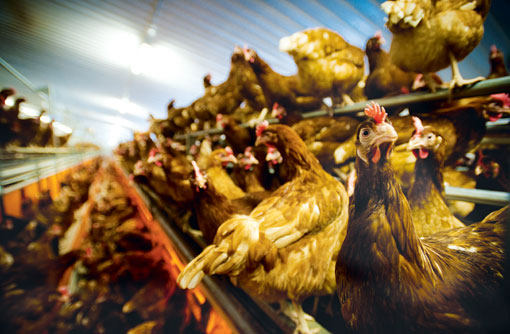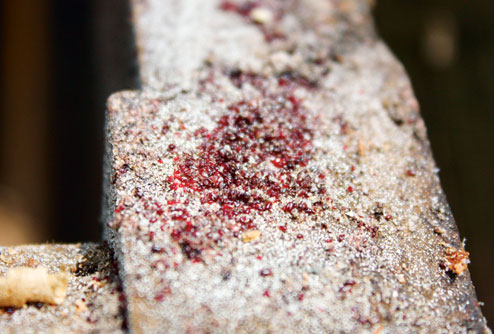Dealing with cost of red mites in the poultry sector

A recent survey suggests that nearly 90% of layer units are affected by red mite and, although difficult to quantify, infestations generally lead to a 10% reduction in egg production.
It is believed to be the most economically damaging parasite of laying hens in Europe, with an estimated cost of €130m (£121m) every year. The UK is one of the most badly affected countries.
The issue is getting worse, too – resistance to conventional control chemicals is rapidly developing.
Heavy infestation of poultry houses results in a loss of egg production because adult female mites feed on hen blood and, in severe cases, the birds become anaemic. The irritation caused by the mites can also cause outbreaks of aggressive pecking and cannibalism.
Mites do not live on the birds, preferring to clamber on to poultry during darkness to feed, before retiring into cracks and crevices. For this reason the extent of infestation is not always easy to determine, although problems tend to be worse in free-range and barn-style percheries due to increased availability of mite hiding places.
A complete lifecycle from egg to egg may be as few as seven days, but mites can survive for up to eight months without a blood feed.
Consequences
The effects of mite infestation are severe both in terms of bird welfare and the financial performance of the flock.
As well as hitting egg production, quality is also compromised with poor shell integrity and blood staining.
Blood-sucking mites not only cause irritation and restlessness, but the consequent anaemia can lead to death. Studies have shown mortality rates rising by between 50% and 75%.
An integrated strategy
- Apply a short-acting mite control acaricide as soon as the house is de-stocked
- Muck-out and remove all equipment to eliminate mite hiding places
- Pressure-wash with a strong detergent – this can help to dissolve a mite’s waxy cuticle
- Apply a coarse spray of disinfectant such as Interkokask
- Use a long-acting acaricide powder or diatomaceous earth on the walls and floor of the house to kill any adult mites which return
- Re-install equipment and seal all crevices
- Re-stock
- Monitor with corrugated cardboard/plastic mite traps
Red mite is also a vector of other pathogenic poultry diseases, both viral and bacterial, including salmonella, Newcastle disease, spirochaetosis, typhoid and chicken pox.

Control and resistance
Traditionally, organophosphates, pyrethroids and carbamates have been the primary weapons of defence against red mite. However, with ever-increasing levels of resistance to these chemicals, combined strategies are required using cultural control methods as well as insecticide treatment.
As a clear demonstration of resistance build-up, in a 2002 trial, traps treated with metriphonate (OP) were shown to successfully reduce mite populations.
However, more recent research has shown that this once-potent acaracide now ranks as one of the least effective mite control products – indeed, no better than simple mechanical cleaning of poultry houses.
The real cost of mites
For a 12,000-bird unit at peak production, a 10% drop in output due to red mite infestation would equate to 8,400 fewer eggs each week. With an average egg price of 7p, that equates to lost revenue of more than £2,500 a month.
Currently, the accepted wisdom is that the rotation of mite control chemicals is the most effective strategy in the fight against resistance. It is also worth getting a specialist laboratory to check mite samples from affected houses for sensitivity to insecticides and any possible resistance.
Alternatives
Now widely used, diatomaceous earth is becoming increasingly popular. A fine powder formed from the fossilised remains of hard-shelled algae, its jagged, microscopic particles damage the exoskeleton of the mites, causing them to dehydrate and eventually die.
The powder can be applied to poultry house walls between restocking and a number of producers are trialling it plastered as a thick slurry on to walls. In free-range houses, providing diatomaceous earth dust-baths may also help in mite control.
Neem oil, harvested from an evergreen tree native to India, has also been reported to be effective. A 92% reduction in mite numbers was observed in poultry houses fitted with traps containing 20% oil in water.
Garlic-based products such as Breck-a-Sol are also now appearing on the market, backed by successful research in the USA.
- This article is based on a presentation by independent pest control specialist Dr Steve Havers at a South West Layers and Game Birds Initiative training day.
